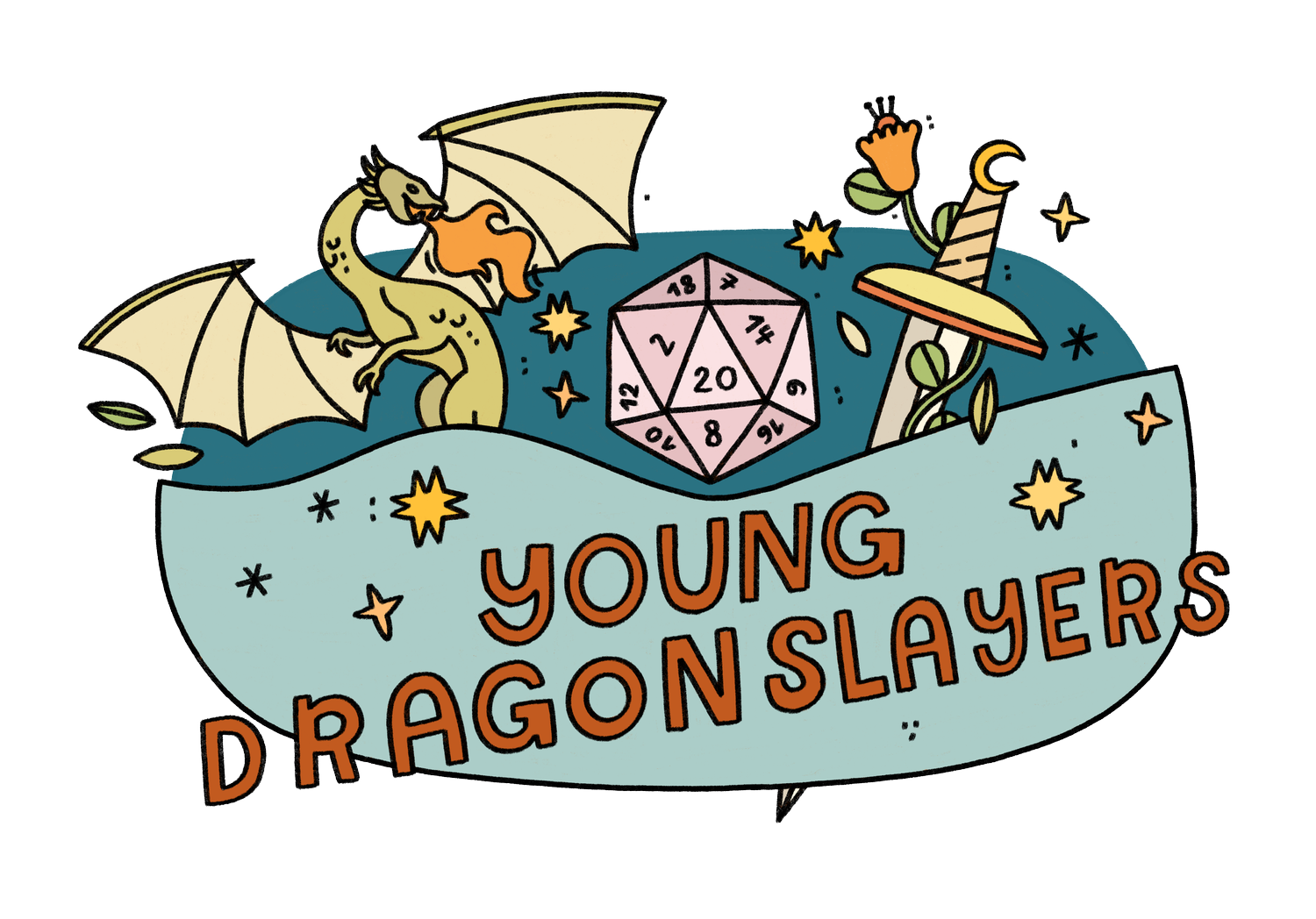10 Steps to Make Your Own Game Like D&D (With a Printable Guide!)
Here at Young Dragonslayers™, we love the game Dungeons & Dragons - it’s our bread and butter (or perhaps you could say, meat and ale)! It’s by far the most popular game of its kind, but it’s not the only one out there. Just like there are plenty of movies outside of the Marvel Cinematic Universe, there are plenty of tabletop roleplaying games outside of Dungeons & Dragons. Some games that our Dungeon Masters enjoy are about things like epic heists, superhero antics, and monster hunting. Lots of awesome people have made these games - and so can you! You don’t have to be a math genius or have a super analytical mind (though you can use both of these skills in designing your game), just a creative idea and a little bit of elbow grease. If you’re a notetaker, you can also use our printable guide to help you keep track of the different steps (or give you some inspiration when you’re stuck without an internet connection)!
Note: This post is based on the guide “You Have Two Stats'' by Thor and Litza Bronwyn and uses examples from Grant Howitt’s “Honey Heist,” John Harper’s “Lasers & Feelings,” and Meglish Media’s “Crystal Caper.”
Find A Premise For Your Roleplaying Game
When making your own game, the first step is to decide on a premise: that is, what your game is about. If you don’t have a premise in mind, think about the movies, books, TV, and video games that you like. What do you like about them? Which of them have fun worlds, character types, technology, or scenarios that might make a fun game? I really like video and card games like Pokémon and Digimon because of all the different kinds of original (and adorable!) creatures. One of my favorite scenarios is in the Pokémon Mystery Dungeon series, where there are no Trainers around and Pokémon team up to explore dungeons and help others in need. Inspired by that, I could summarize a premise for my game as “Elemental creatures work together to fight bad guys and save the day.”
Pick Stats For Characters In Your Game
There are lots of different ways you can decide on stats for your player characters. For the purposes of this post, I’m following the guide “You Have Two Stats” by Thor and Litza Bronwyn on how to make a one-page game, so you can bet I recommend you pick two stats! Think about what kinds of abilities a character could have in your world and what kinds of things determine what they can and can’t do. Honey Heist, a game by Grant Howitt about bears in hats planning a heist, has Bear (“Use to maul stuff, run & climb, shrug off damage, scare people, and generally do bear stuff”) and Criminal (“Use to do anything not directly related to being a bear”). In my game, which I’ll call Rollémon, I’ll pick Strength (to attack, pick things up, lift things, etc) and Agility (to avoid attacks, get into tricky places, etc). You’ll also need to explain how rolls using these stats are determined; typically, a single die is rolled, and if the number on the die is above/below the stat number, the action succeeds. Which die you choose (six-sided, twenty-sided, ect) will determine the range of stats in the next section.
Also decide if characters in your game will have a damage track, something with dire consequences if it reaches 0. Name the track something that fits your game: it can be something related to physical well-being, like Hit Points or Stamina (Rollémon, of course, will be using Hit Points), or something more esoteric, like Motivation or Moxie.
Decide How To Assign Stats
Now that you have some character stats in mind, decide how a character's stats are chosen, keeping in mind what kind of dice your game uses. In Honey Heist, where six-sided dice are used, both Bear and Criminal start at 3, and there is no damage track. If you’d like to make it more complex, you can give players a certain number of points to spend between the stats, include specific player-character roles that have different sets of stats, or come up with your own clever system! In Rollémon, I decided to use six-sided dice and create different player-character roles with different stats - you can see what I chose in the next section.
Think about if you want these stats to be able to change during the game; if, so explain how the two stats can change. Crystal Caper, a game by Meglish Media, is about magical girls with the (fitting) stats Magic and Girl. In the game, gossiping among the party or failing at a plan moves a point from Magic to Girl, while flashing back to a moment when friendship overcame obstacles moves a point from Girl to Magic. If the stats can be changed, think about if anything special happens when a stat reaches 6.
If you included one, decide how many points are on a character’s damage track, how this track might change, and what happens when it hits zero. For Rollémon, I decided that different roles have different Hit Points, Bad Guys can take away one Hit Point from one Rollémon on their turn, and when a Rollémon has zero Hit Points, they are knocked out and unable to act.
Pick What Types of Characters Are In Your D&D-Style Game
Part of the fun of tabletop roleplaying games are the different kinds of characters that can all gather in one party. In D&D, these are typically determined by a class (i.e. Wizard, Barbarian, Rogue, ect). Think about the premise of your game and list what kind of roles a character could play in that premise. In Lasers & Feelings, a game by John Harper about exploring space, the roles on the spaceship are Doctor, Envoy, Engineer, Explorer, Pilot, Scientist, or Soldier. For Rollémon, I decided on The Buffer, The Healer, The Sneaky One, and The Attacker (If you decided to determine a character's stats based on their role, you can determine that now. “The Sneaky One,” for example, has a Strength of 2, an Agility of 5, and 3 Hit Points).
You can also think about if you want more aspects for characters in your game. If so, you can make lists for these as well. True to their inspiration, I gave Rollémon characters an Element (Water, Fire, ect) and an Animal Inspiration (Canine, Feline, ect). You could also include a list of items for characters to pick from, a list of weaknesses your characters possess, or any number of aspects that fit your vision for the game.
Add More Fun Stuff To Your D&D Game
Now that you’ve written down the core rules, you can add in other mechanics. These can be special moves, additional rules, or, really, anything else you think should be a part of your game! If you’d like to give GMs some help, you can also come up with extra story ideas for GMs to put in the game. This is where you can let your imagination go wild and give potential GMs an idea of what kind of game you’ve made. Crystal Caper includes some ideas for places where the crystals could be held, like a Traveling Circus or a Moon Castle. For Rollémon, I decided it would be fun to include different types of Bad Guys, challenges for the players to complete, and, of course, adorable Rollémon for them to save.
Time To Play!
There’s so much you can do with just your imagination and a piece of paper - throw dice into the mix, and you’ve got hours and hours of fun making up stories and playing games together! If you want to learn to play games like this - about magical girls, space explorers, or even bears in hats - we run tween and teen games online where professional Game Masters (like me!) make up a unique story for each group. If you want to learn to be a Game Master yourself, we also have an online course for tweens and teens to learn to make and run their very own one-shot. Check it out, and share any games that you make with us - we’d love to see them!








